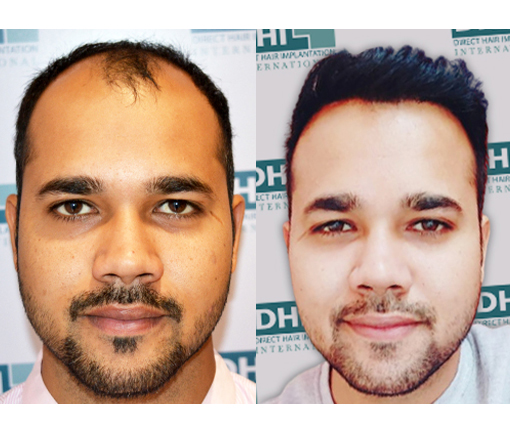What to Expect After Hair Transplant Treatment

Getting a hair transplant is a life-changing event. Most people wonder if it will fetch the desired results and if it will work or not. Results of hair transplants, however, are miraculous and help patients regain self-esteem and confidence. It is one of the most effective treatments for patients who are struggling with hair loss problems. If you were to look at the several examples that are available of people before and after getting a hair transplant, you will notice that people get a healthy regrowth of hair in the affected area on their scalp. It also helps in boosting their morale after getting the procedure done.
Hair Transplant plays a crucial role in restoring the self-confidence and the density of hair in many people. It is due to the positive hair transplant results that the number of people opting for the procedure is increasing by the day.
What is a hair transplant?
Before we dive into the depths of hair transplant results, it is important to understand what the entire hair transplant procedure is all about. The purpose of a hair transplant is to restore healthy hair follicles into areas where hair follicles have become inactive, causing baldness. This procedure is done using microsurgical technologies. It is an extremely suitable choice for those people who are suffering from problems such as hair thinning and hair loss. The main step in a hair transplant is that the patient’s healthy hair is added to the area on the scalp which is affected due to hair loss.
In today’s day and age, more than half of men touching the age of 30 to 40 are facing hair loss issues or baldness. It affects their overall confidence and self-esteem. Two of the most common symptoms of hair loss in male is the regression of the hairline into the forehead area and the opening of the apex.
The way men lose their hair is quite different from the process in women. In women, it’s often a gradual thinning that starts at some point and spreads to other parts on top or near your head. Women rarely face a receding hairline; their front hair usually stays intact. The Norwood scale is the most widely used classification system for determining the extent of male pattern baldness. It defines seven stages of baldness, beginning with a full head of hair and progressing to stage 7 when baldness begins to affect the sides of the head, and only a thin ring of hair encircles the exterior of the head.
The Ludwig classification system assesses the severity of female pattern baldness. The Ludwig classification system is divided into three stages: Type 1 indicates early signs of balding, such as on top of the head or a thinning crown, while Type 3 is the most intense, with hair considerably decreased on top of the head and crown.
At DHI, the hair transplant results are 100% natural and positive because each transplant is customized and performed as per the individual requirement. The hair follicles from the donor area resistant to shedding are extracted. The extracted hair follicles are loaded into the patented DHI implanter and then implanted into the bald area on the scalp. The main goal behind this entire process is to restore hair in the affected area with the most natural and healthy appearance possible. The hair transplant procedure from the DHI technique is painless, scar free, and has no downtime. This allows hair follicles to grow naturally with maximum density.
What to expect after a hair transplant?
People who want to get a hair transplant done are always curious about how the hair transplant results would be. It is crucial to keep in mind that this procedure is crucial and sensitive in nature. If you wish to see positive hair transplant results then you must follow the post-operative recommendations that are prescribed by the best hair transplant doctor. It is critical for achieving the best outcomes.
Many patients see the real benefits of the procedure after six to nine months following surgery. It may even take up to a year in some patients. An important point to remember is that the transplanted hair will fall out between two to eight weeks post-surgery – there is nothing to worry about. This is quite natural and new hair will grow back in its place.
The recovery procedure
The procedure of a hair transplant may take anywhere between several hours or even days to complete.
It mainly depends on the total number of hairs that needs to be implanted and also the medical history of the patient, if any precautionary measure has to be taken during the procedure. However, you can go home on the same day of the procedure and start your normal schedule from the next day but should avoid any exhaustive physical activities. Once the surgery is complete, the surgeon removes the bandages. Once 2 to 3 weeks have passed post the surgery, the transplanted hair may begin to fall out – you must not worry in such a case. The real hair transplant result begins to show within the next few months. Some surgeons may even recommend their patients take an effective hair-growing drug that helps in boosting hair growth post the hair transplant procedure. There are some important hair care tips that you must follow after your procedure to get positive hair transplant results. They are:
- Wash your hair after a few days, do not wash your hair immediately after the procedure. Once you do begin to wash your hair, be mindful to use gentle and mild shampoos in the first few weeks. Follow the precautions which the surgeon prescribes.
- After the DHI hair transplant, avoid excessive exercise for at least a week after the procedure. Also, avoid indulging in other activities that can cause excessive sweating, like spa, sauna, and steam.
- Be mindful not to push a brush or comb down on the new grafts for 3 weeks. Be strict in following this, as it will have a direct effect on your hair transplant results.
- Do not wear any hats or a pullover shirt till the time your doctor says it is okay to do so. Consult your doctor once before you start wearing pullover shirts or even a hat.
The main reason behind hair fall or hair thinning may be stress, poor diet, hormones, or genetics. Anyone can be prone to hair loss, especially men. When you do face this problem, you can consider a hair transplant as the permanent solution. Once the initial shock of the hair transplant goes, the follicles continue to grow hair regularly and you will get your hair back. Are you looking for a trusted and well-known place to get your hair transplant done? Book a hair transplant consultation today or contact our Hair Expert on 1800 103 9300 and get your original style and confidence back – quite literally!
Say goodbye to hair loss today and say hello to confidence!
The content is Reviewed By Dr. Kuntal Deb Barma.
